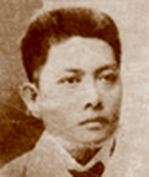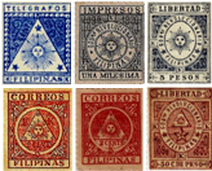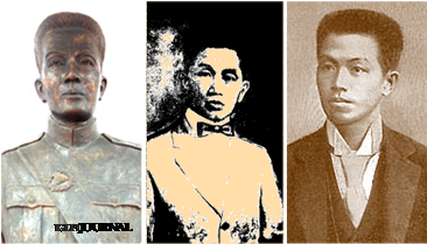Masons in Philippine History
General Emilio Aguinaldo was initiated into Masonry on January 1, 1895 at Logia Pilar No 203 in Imus, Cavite. His Masonic name was Colon (Columbus). Logia Pilar, named after the patron Saint of Imus, Nuestra Señora del Pilar, was founded by Rev Fr Severo Buenaventura, a Catholic priest; Juan Castañeda and Cayetano Topacio. It was chartered by the Grande Oriente Español on June 5, 1894.
In 1896, between January and August, some members of Logia Pilar No 203 created Triangulo Magdalo in Binakayan, Kawit Cavite. However, it was overtaken by the events of the revolution and dissolved after its documents and paraphernalia were lost and eventually forgotten. (Susana Cuartero Escobés, 2006, La Masoneria Española en Filipinas Vol 1, p 148)
It could be presumed that Aguinaldo was one of the proponents of the Triangulo Magdalo because in 1914, the name Magdalo was revived when Aguinaldo and ten other members of Logia Pilar formed Logia Magdalo in Kawit under the auspices of the Gran Logia Regional de Filipinas. On December 21, 1914, it was chartered by the Grande Oriente Español as Logia Magdalo No 371. Aguinaldo served as its Venerable Maestre from 1914 to 1915.
Logia Magdalo affiliated with the American sponsored Grand Lodge of the Philippine Islands in 1917 and assigned the number 31. In 1928 a rift among its members resulted in a petition to rename the lodge which was approved by then Grand Master Teodoro M. Kalaw on October 10. Magdalo Lodge became Ibarra Lodge No 31. General Aguinaldo ceased to attend meetings and was declared dormant.
Logia Magdalo was later revived as Logia Magdalo No 79 by the Gran Logia Nacional de Filipinas and still active today.
In 1955, General Aguinaldo was invited by then incoming Grand Master Camilo Osias as guest speaker for the 39th Annual Communications of the Grand Lodge of the Philippines. For such occasion, at Ibarra Lodge No 31, (formerly Logia Magdalo No 371), Aguinaldo at the age of 86, renewed his Masonic vows in the presence of grand officers the Grand Lodge of the Philippines.
He died on February 6, 1964. In the same year, Ibarra Lodge No 31 was renamed Aguinaldo Memorial Lodge. In 2006, the lodge joined six other regular lodges to form the Independent Grand Lodge of the Philippine Islands. It was renamed President Emilio Aguinaldo Memorial Lodge No 5.
In 1896, between January and August, some members of Logia Pilar No 203 created Triangulo Magdalo in Binakayan, Kawit Cavite. However, it was overtaken by the events of the revolution and dissolved after its documents and paraphernalia were lost and eventually forgotten. (Susana Cuartero Escobés, 2006, La Masoneria Española en Filipinas Vol 1, p 148)
It could be presumed that Aguinaldo was one of the proponents of the Triangulo Magdalo because in 1914, the name Magdalo was revived when Aguinaldo and ten other members of Logia Pilar formed Logia Magdalo in Kawit under the auspices of the Gran Logia Regional de Filipinas. On December 21, 1914, it was chartered by the Grande Oriente Español as Logia Magdalo No 371. Aguinaldo served as its Venerable Maestre from 1914 to 1915.
Logia Magdalo affiliated with the American sponsored Grand Lodge of the Philippine Islands in 1917 and assigned the number 31. In 1928 a rift among its members resulted in a petition to rename the lodge which was approved by then Grand Master Teodoro M. Kalaw on October 10. Magdalo Lodge became Ibarra Lodge No 31. General Aguinaldo ceased to attend meetings and was declared dormant.
Logia Magdalo was later revived as Logia Magdalo No 79 by the Gran Logia Nacional de Filipinas and still active today.
In 1955, General Aguinaldo was invited by then incoming Grand Master Camilo Osias as guest speaker for the 39th Annual Communications of the Grand Lodge of the Philippines. For such occasion, at Ibarra Lodge No 31, (formerly Logia Magdalo No 371), Aguinaldo at the age of 86, renewed his Masonic vows in the presence of grand officers the Grand Lodge of the Philippines.
He died on February 6, 1964. In the same year, Ibarra Lodge No 31 was renamed Aguinaldo Memorial Lodge. In 2006, the lodge joined six other regular lodges to form the Independent Grand Lodge of the Philippine Islands. It was renamed President Emilio Aguinaldo Memorial Lodge No 5.
 Santiago Alvarez
Santiago Alvarez
Magdalo was Aguinaldo’s Katipunan symbolic name, derived from the name of Kawit’s patron saint Santa Maria Magdalena.
It was his long time friend and brother-in-law, Santiago V. Alvarez who accompanied Aguinaldo (and Raymundo Mata) to Andres Bonifacio for initiation into the Katipunan in the evening of March 14, 1896. Bonifacio’s house was located at Cervantes street (now Rizal Avenue) in the San Ygnacio area of Bambang. (Alvarez, 1992)
In his memoirs serialized in the weekly publication Sampagita from July 24, 1927 to April 15, 1928, Santiago Alvarez said he took notice of Aguinaldo’s prolonged initiation and attributed it to the Katipunan’s similarities to Masonry.
It was his long time friend and brother-in-law, Santiago V. Alvarez who accompanied Aguinaldo (and Raymundo Mata) to Andres Bonifacio for initiation into the Katipunan in the evening of March 14, 1896. Bonifacio’s house was located at Cervantes street (now Rizal Avenue) in the San Ygnacio area of Bambang. (Alvarez, 1992)
In his memoirs serialized in the weekly publication Sampagita from July 24, 1927 to April 15, 1928, Santiago Alvarez said he took notice of Aguinaldo’s prolonged initiation and attributed it to the Katipunan’s similarities to Masonry.
 Government seals used in stamps
Government seals used in stamps
Many active Masons held important positions in the revolutionary government of General Emilio Aguinaldo: Apolinario Mabini, private counselor, later head of the cabinet; Baldomero Aguinaldo and Ambrosio Flores, Secretaries of War; Gracio Gonzaga, Secretary of Finance; General Antonio Luna, Director of War; Timoteo Paez, Bonifacio Arevalo and Venancio Reyes, War Commissaries; Mariano Llanera, Vicente Lukban, Juan Castañeda, Pantaleon Garcia, Mariano Trias, Jose Alejandrino, Manuel Tinio, Servillano Aquino, Venancio Concepcion and Mamerto Natividad, Military Generals; Francisco Joven, Colonel of Infantry; Jose Sofio Banuelos, Lieutenant Colonel of Staff; and Estanislao Legaspi, Lieutenant Colonel of Infantry.
On January 2, 1899, General Emilio Aguinaldo formed his Cabinet or Council of Government. All members were Masons:
 Apolinario Mabini, Mariano Trias, Baldomero Aguinaldo, Teodoro Sandico, Gracio Gonzaga
Apolinario Mabini, Mariano Trias, Baldomero Aguinaldo, Teodoro Sandico, Gracio Gonzaga
Apolinario Mabini, his chief adviser as Cabinet President and Secretary of Foreign Affairs
Mariano Trias, Secretary of Finance
Baldomero Aguinaldo, Secretary of War
Teodoro Sandico, Secretary of the Interior
Gracio Gonzaga, Secretary of Welfare, Public Instruction, Public Works, Communications, Agriculture, Industry and Commerce.
A republican constitution was promulgated on January 21 and the first Philippine Republic inaugurated two days later on January 23, 1899 in Malolos, Bulacan.
Mariano Trias, Secretary of Finance
Baldomero Aguinaldo, Secretary of War
Teodoro Sandico, Secretary of the Interior
Gracio Gonzaga, Secretary of Welfare, Public Instruction, Public Works, Communications, Agriculture, Industry and Commerce.
A republican constitution was promulgated on January 21 and the first Philippine Republic inaugurated two days later on January 23, 1899 in Malolos, Bulacan.
